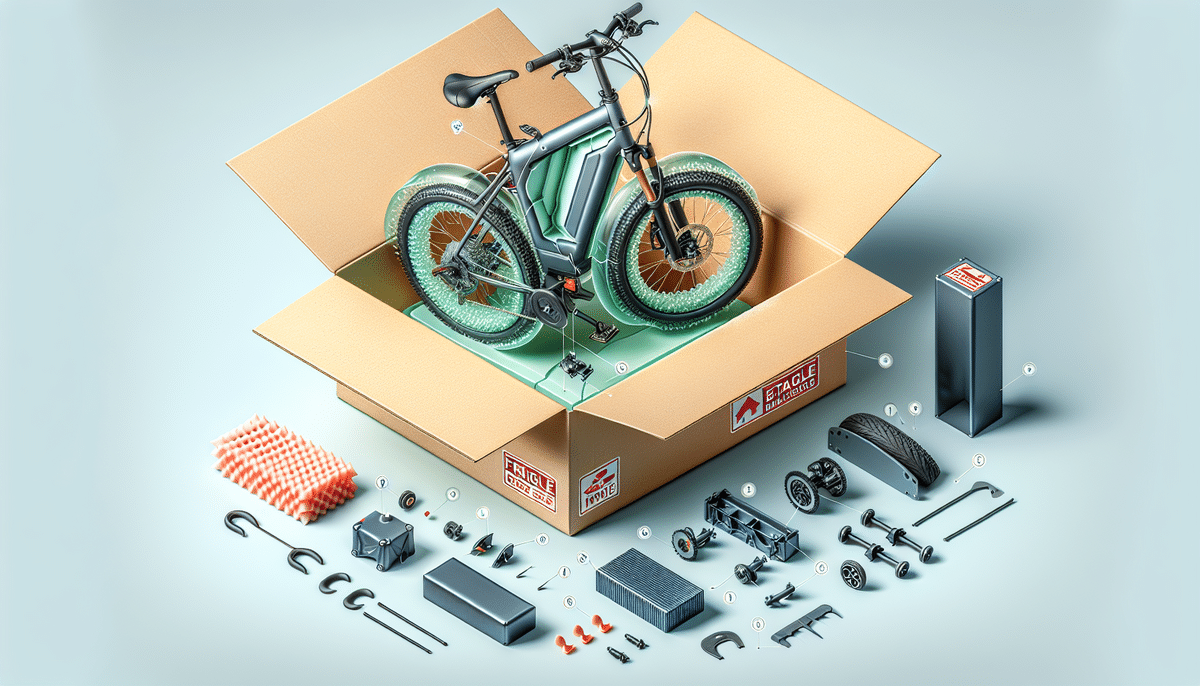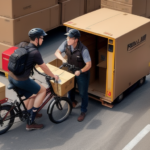How to Safely Ship an Electric Bike
Electric bikes have surged in popularity, with sales increasing by over 23% in 2023 alone, according to the British Cycling Federation. They offer a convenient and eco-friendly alternative to traditional bicycles. However, transporting electric bikes can be more complex than simply placing them in the back of a truck or loading them onto a plane. In this article, we'll cover everything you need to know about safely shipping an electric bike.
Why Shipping an Electric Bike Requires Special Care
Electric bikes are significantly heavier than traditional bicycles, often weighing between 40 to 70 pounds due to components like batteries and motors that need protection during shipping. This increased weight and complexity make shipping an electric bike more challenging than a regular bike. Proper packaging and handling are crucial to ensure that the bike and its components arrive at their destination in excellent condition.
In addition to the weight and added components, electric bikes also require special attention to their electrical systems. Securing and protecting the wiring and connections during shipping is essential to prevent damage or disconnections. Choosing a shipping method that accommodates the size and weight of the bike, and communicating any special handling instructions to the shipping company, are key steps in the process.
Preparing Your Bike for Shipping: Essential Steps to Take
Before shipping your electric bike, it's essential to properly prepare it for the journey. Start by disconnecting the battery to comply with shipping regulations and prevent potential hazards. Remove any loose items from the bike to avoid damage during transport. Document the bike's condition by taking photos from all angles and noting any pre-existing damage.
Deflating the tires slightly can help prevent damage from changes in air pressure during transport. Additionally, consider removing detachable accessories or components, such as pedals or handlebars, to prevent them from getting lost or damaged. Thoroughly cleaning your bike before shipping not only protects it during transit but also makes it easier to inspect for any damage upon arrival.
Finally, use a sturdy box and ample padding materials to securely package your bike. Ensuring that the bike is well-protected from bumps and jostles during transport is vital for safe delivery.
Choosing the Right Shipping Company for Your Electric Bike
Selecting a shipping company with experience in handling electric bikes is crucial. A reputable company will know how to properly package and transport your bike to prevent damage. Research and read reviews to ensure you choose a dependable carrier.
Cost is another critical factor when selecting a shipping company. While some companies may offer lower prices, they might not provide the same level of service or protection for your bike during transit. Compare prices and services from different companies to find the best balance between cost and quality.
Insurance is an important consideration. Accidents can occur during transit, and having insurance provides peace of mind and financial protection in case of damage or loss. Carefully review the insurance policy to understand what is covered and what is not.
Packing Your Electric Bike: Materials and Techniques to Use
The materials and techniques used to pack your electric bike are crucial for ensuring it arrives unscathed. Carefully wrap the bike in bubble wrap, and pack any removed components separately. High-quality packing materials such as cardboard boxes and foam padding are ideal for electric bikes.
Choosing the right box size and weight capacity is important. A box that is too small or too large can increase the risk of damage during transit. It's recommended to use a box specifically designed for shipping bikes, as these are typically made with stronger materials and reinforced corners for extra protection. Additionally, label the box with "Fragile" and "This Side Up" stickers to ensure careful handling during shipping.
Tips for Disassembling and Reassembling Your Electric Bike
When disassembling your bike for shipping, keep all parts together and label them accordingly. This organization will make reassembling the bike much easier upon arrival. Taking photos during disassembly provides a reference to ensure correct reassembly.
Using the right tools is essential to avoid damaging the bike or its components. Ensure you have the necessary wrenches, screwdrivers, and other tools before starting the disassembly. Refer to the bike's manual or consult a professional bike mechanic if you're unsure which tools to use.
During reassembly, take your time and double-check each part. Ensure all components are properly aligned and tightened, and verify that the bike functions correctly before riding. If you're not confident in your ability to reassemble the bike, consider seeking assistance from a professional bike shop.
Ensuring Safe Transportation of Your Electric Bike: What to Look Out For
During transportation, monitor a few key aspects to ensure your electric bike is handled safely. Load the bike last and unload it first to minimize the risk of damage. Ensure the bike is securely fastened during transport to prevent movement that could lead to scratches or breaks.
Packaging plays a vital role in protecting your bike. Use a sturdy box or a bike-specific case to shield your bike from potential damage. Remove and separately wrap any loose accessories or parts to prevent them from scratching or damaging the bike. These extra precautions help ensure your electric bike arrives in the same condition it was in when shipped.
Common Mistakes to Avoid When Shipping an Electric Bike
One common mistake when shipping an electric bike is using improper packaging materials. Inadequate packaging can result in damage during transport, so it's essential to use high-quality packing materials.
Failing to disconnect the battery before shipping is another frequent error. Shipping an electric bike with an attached battery can lead to damage to the bike and potential fire hazards. Always disconnect and secure the battery according to the manufacturer’s instructions.
Properly labeling the package is also crucial, especially indicating that it contains a lithium-ion battery. This labeling is required by law and helps prevent fines or the package being rejected by the shipping carrier. Additionally, purchasing insurance for the shipment is advisable, as electric bikes are valuable and any damage during shipping can lead to costly repairs or replacements.
By avoiding these common mistakes and taking the necessary precautions, you can ensure that your electric bike arrives safely and in good condition.
Insurance Coverage for Shipping an Electric Bike: What You Need to Know
Understanding the insurance coverage offered by the carrier is essential when shipping an electric bike. Most carriers provide basic insurance that covers damage incurred during shipping. However, if your electric bike is a significant investment, you might consider additional insurance to protect your investment fully.
Be aware that some carriers have restrictions on shipping electric bikes due to the lithium-ion batteries they contain. Always check with the carrier beforehand to confirm they allow electric bikes to be shipped and to understand any additional requirements or fees.
Proper packaging not only protects your bike during shipping but may also be a requirement for insurance coverage. Use a sturdy box and ample padding to safeguard your electric bike during transit, ensuring compliance with the carrier’s insurance policies.
International Shipping Considerations for Electric Bikes
Shipping an electric bike internationally involves additional complexities compared to domestic shipping. Each country has its own regulations regarding the import of electric bikes, so thorough research is necessary to ensure compliance with the destination country's laws.
Some countries require additional documentation or permits for the import of electric bikes. It's crucial to check with the customs department of the destination country to ensure you have all necessary paperwork in order. Additionally, certain countries may restrict the types of batteries that can be shipped, so verifying regulations regarding lithium-ion batteries beforehand is essential.
Understanding the Costs of Shipping an Electric Bike
Shipping an electric bike can be costly, particularly if you opt for a professional shipping company. The cost varies based on factors such as distance, weight, and the destination of the bike. Obtaining quotes from multiple shipping companies allows you to compare prices and secure the best deal.
The type of packaging used can also affect the shipping cost. Custom-made boxes or crates may increase the expense, but investing in high-quality packaging materials ensures your bike arrives safely and without damage. Balancing cost and protection is vital when selecting the packaging for your electric bike.
Safety Tips for Receiving Your Shipped Electric Bike
Upon receiving your shipped electric bike, conduct a thorough inspection for any damage that may have occurred during shipping. Check the bike carefully and document any damage by taking photos if necessary. Ensure all parts are included and that the bike has been reassembled correctly.
How to Troubleshoot Common Issues After Receiving Your Shipped Electric Bike
If you encounter any issues with your electric bike after receiving it, such as damaged components, contact the shipping company immediately and document the damage. Most reputable shipping companies will work with you to resolve any issues that arise.
Conclusion: Best Practices for Safely Shipping an Electric Bike
Shipping an electric bike can present challenges, but by following the best practices outlined in this article, you can ensure your bike arrives at its destination in excellent condition. Proper packaging, selecting a reputable shipping company, and disconnecting the battery are essential steps to take when shipping your electric bike. With these precautions in place, shipping your electric bike can be a smooth and hassle-free experience.






















